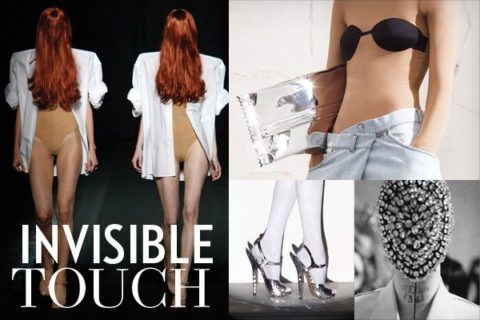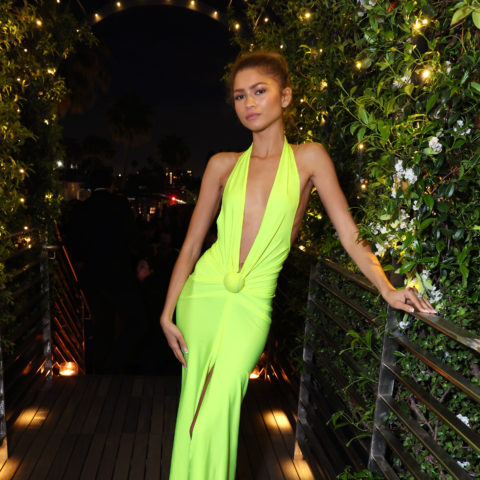Maison Martin Margiela for H&M: We travel to Paris and go behind the curtain at the legendarily secret house

See the Maison Martin Margiela for H&M collection »
We live in an age of TMI: Too. Much. Information. With the constant barrage of tweets, Facebook updates, weekly rags and reality shows (hello, Kardashians) we have all become gossip girls. The fashion industry, that celebrated circus of all things fabulous and freaky, is no exception. From Marc Jacobs’ super-toned and super-tattooed body (we know the intimate details of every one of his 30+ collection) to Karl Lagerfeld’s spoiled Siamese kitty, Choupette (the white fluff ball has two maids and dines off Goyard dishes), it seems a good mystery hasn’t been taken off the shelf in quite some time. Surprising then, or perhaps not at all, that H&M’s next designer collaboration is with Maison Martin Margiela—a visionary house shrouded in secrecy.
Previously, the Swedish fast-fashion mega retailer has partnered with spotlight-driven houses like Versace, Stella McCartney, Roberto Cavalli and Lanvin—brands with instant name recognition and obvious mass appeal. Conceptual didn’t make the cut until Comme des Garçons’ Rei Kawakubo brought her deconstructed jackets, dhoti pants and dark palette to this high street store in 2008. Judging by the lines that snaked around city blocks across the globe, that eyebrow-raising experiment proved to be more right-on than radical. Clearly, there’s an appetite for the avant-garde, but how about for anonymity?
H&M’s latest star, Maison Martin Margiela, is a multi-million-dollar fashion house that has been quietly built from deep within the shadows. No branding, no advertising, no marketing. Since the label’s inception in 1988, there has never been a face of the brand. A name, yes, but the person attached to it—Belgian designer Martin Margiela—remains a man of mystery. Like the Great and Powerful Oz, he was spoken of but rarely seen or photographed. Interviews were never granted. Instead, external communication was sent via fax and referred to “we,” not “I.” The rumours swirled (did he even exist?) but he continued to maintain an extremely low profile, allowing his ideas to take centre stage: vintage garments were reworked by hand and house signatures like unravelled seams and silhouettes that played with proportion defied convention. In 2002, Diesel founder Renzo Rosso, another famous recluse, became the primary shareholder of the company. The two men worked together until 2009, when Margiela decided to leave the Maison. Today, Maison Martin Margiela continues to function as a collective, highlighting the work of the group rather than that of one designer. The “we” continues to reign: garment labels still bear a chart of numbers corresponding to collections (zero to 23), rather than a designer name; on the runway, models’ faces are frequently covered to let the clothes do the talking; and the designers wear stark white lab coats as a repudiation of hierarchy and a nod to the haute couture ateliers of yesteryear.
Upon my arrival at the MMM headquarters in Paris—a former convent turned industrial design school dating back to the 18th century—a group of designers lines the front entrance, each one dressed in the house’s democratic uniform. Everything is white. From the wardrobes to the walls to the workspace, the atelier is a blank canvas from which ideas spring to life. Even the chandeliers and chairs are cloaked in white cotton sheets. The reception desk is made from supermarket checkouts. Our group is here to preview the H&M collection, but first we are taken on a tour. Representatives from the lab coat crew stand at every doorway, holding up signs with typed instructions for our audio headsets: Press 1, Press 2. There is no talking and we are forbidden from taking photos of the Maison’s team. We visit the press office (even the water dispensers are covered in white dust covers); the commercial showrooms, where the buying for the Summer 2013 pre-collection is in full swing; and the Collections room, where the Fall 2012 haute couture line is currently housed. Despite the fact that I attended the show the night before, a sleeveless jacket made from several vintage baseball gloves has me completely spellbound. It’s surreally cool. The archive room in the attic contains every garment shown since the house’s first collection in Spring 1989—sadly, it’s off-limits. We make our way into another room to see the H&M installation. It’s pitch-black. We stumble into our seats and the doors close. A man’s voice comes over a loudspeaker and the show begins.
The collection is a “Re-Edition” of iconic Maison Martin Margiela clothing and accessories for women and men. Each piece is labelled with a tag indicating the season from which it originated, spanning the Maison’s 23 years. Throughout the peepshow-style presentation, the models, or rather their body parts, are spotlit one by one to showcase the arty/cool looks from the line. Standouts include a trompe l’oeil tattoo top (Spring 1989); a duvet coat (Fall 1999); oversized five-pocket jeans (Fall 2000); and a giant pink foil candy-wrapper clutch, bar code and all (Spring 2010). As for the Mr., a guitar-cover weekend bag (Spring 2008) and a leather jacket composed of belts (Fall 2007) elicit the biggest buzz. In true Margiela style, the entire collection is concept-driven, but many of the pieces—impeccably tailored blazers, crisp white dress shirts and body-con LBDs—are both witty and sexy and will transcend the trends for years to come.
Post-show, our group gathers in the courtyard for cocktails and hors d’oeuvres. The designers circulate for a short time, then seem to disappear into thin air. That’s the thing about magicians; they never reveal their secrets.







